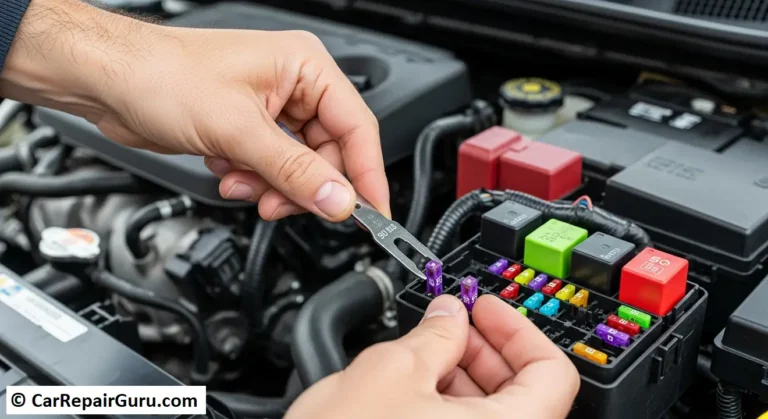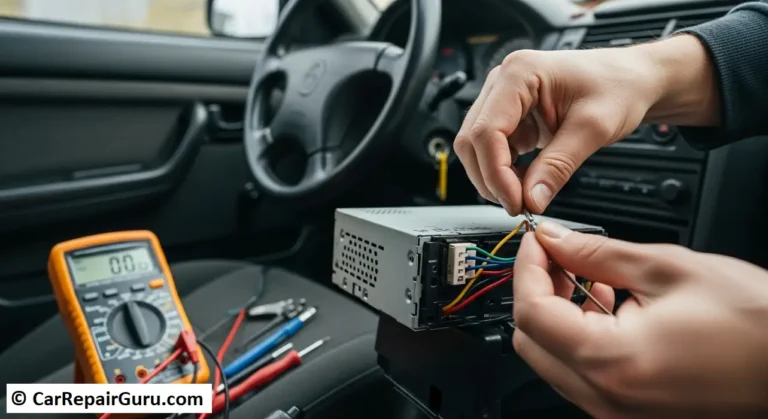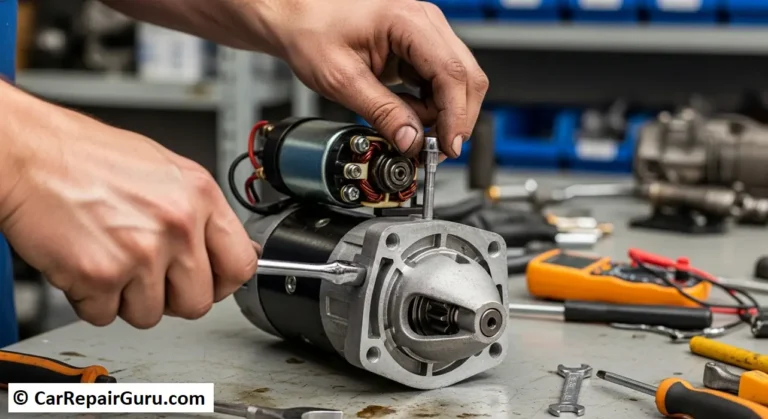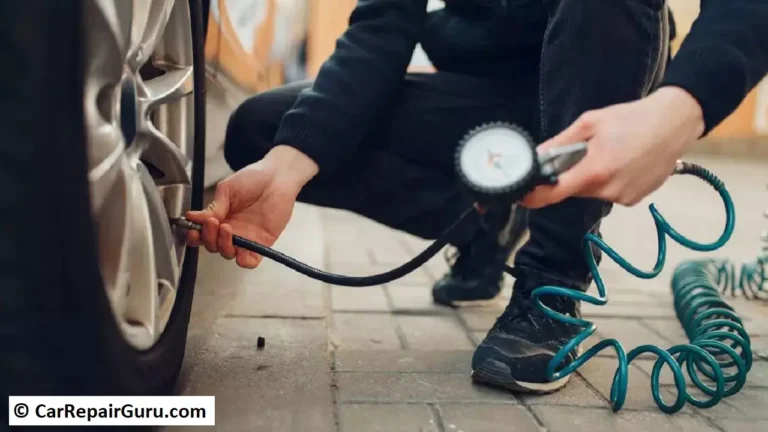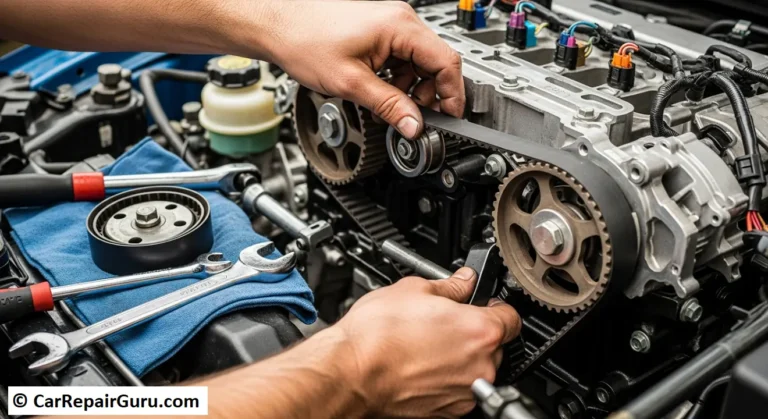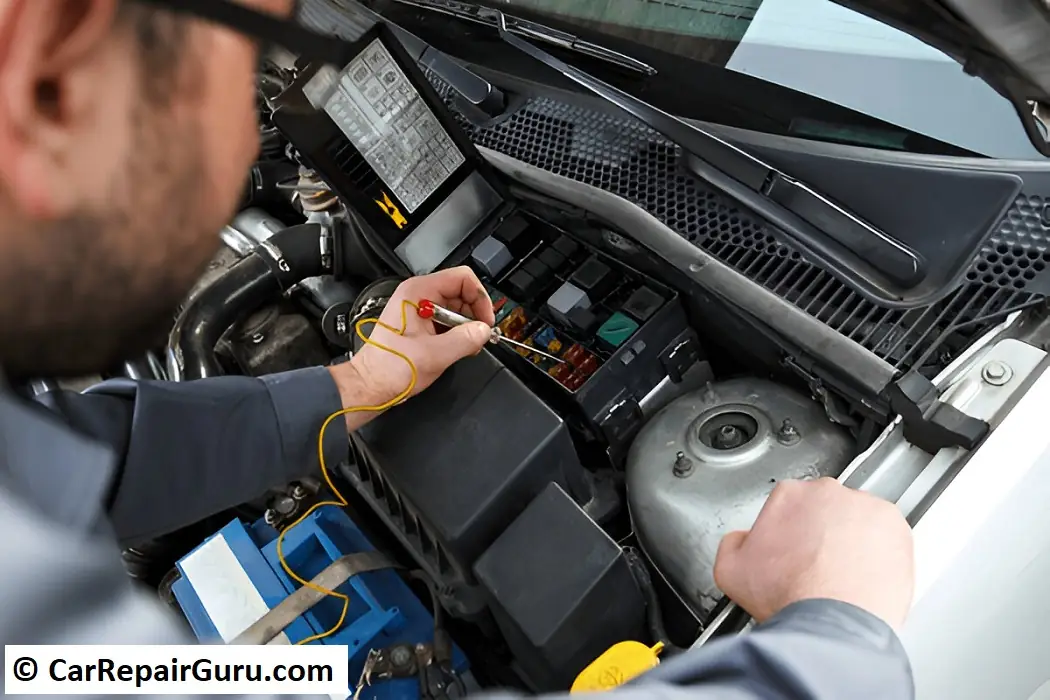
Your car’s electrical system is like its nervous system—it powers everything from starting the engine to operating lights and accessories. Unfortunately, common car electrical problems can leave you stranded if they aren’t identified and fixed promptly.
In this guide, we’ll explore frequent electrical issues, how to troubleshoot them, and when to seek professional help. Whether it’s a dead battery, a failing alternator, or flickering lights, knowing what to do can save you time, money, and headaches.
Dead Battery or Charging Issues
Symptoms of Car Battery Problems
A car battery is essential for powering the starter motor and electronics, so when it fails, you’ll notice unmistakable signs:
- Difficulty Starting the Car: A weak or dead battery often causes the engine to crank slower than normal or not at all.
- Dim or Flickering Lights: Dimming headlights or interior lights when starting the car is a telltale sign of low battery voltage.
- Dashboard Warnings: Many modern vehicles have a battery warning light that illuminates when there’s an issue with the charging system.
What Causes Battery Drain?
Battery drain can result from:
- Parasitic Draws: Devices like interior lights or faulty electronics that consume power even when the car is off.
- Frequent Short Trips: These prevent the alternator from fully recharging the battery.
- Old or Worn-Out Battery: Batteries naturally degrade over time, typically lasting 3–5 years.
Understanding these symptoms and causes can help you catch issues early and prevent complete breakdowns.
Troubleshooting Car Battery Problems
Proper diagnostics are crucial for resolving battery-related electrical issues. Here’s how you can troubleshoot effectively:
1. Test Battery Voltage with a Multimeter
- Set the multimeter to DC voltage.
- Connect the red lead to the positive terminal and the black lead to the negative terminal.
- A healthy battery should read around 12.6 volts when fully charged. If the reading is below 12 volts, the battery likely needs recharging or replacement.
2. Inspect and Clean Battery Terminals
- Check for corrosion, which appears as a white or greenish deposit on the terminals.
- Clean terminals with a mixture of baking soda and water using a stiff brush.
- Ensure connections are tight to improve conductivity and reduce resistance.
3. Check the Alternator
A faulty alternator can mimic battery problems. Test its output while the engine is running. A properly functioning alternator should produce between 13.5 and 14.5 volts.
Taking these steps helps pinpoint the root of the problem and ensures your battery operates efficiently.
Preventing Battery-Related Electrical Issues
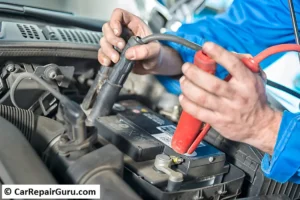
Preventative maintenance goes a long way in extending the lifespan of your car battery. Follow these practices:
1. Perform Regular Inspections
- Check the battery’s condition every few months. Look for signs of swelling, leaks, or corrosion.
- Test the voltage periodically, especially before long trips or in extreme weather.
2. Replace Old Batteries on Time
- Don’t wait until the battery completely fails. Replace it as it approaches the end of its lifespan, typically 3–5 years.
3. Use High-Quality Cables
- Low-quality or damaged cables can lead to inefficient power transfer and voltage drops. Invest in durable cables and regularly inspect them for wear or fraying.
4. Limit Power Usage When the Engine is Off
- Turn off interior lights, unplug charging devices, and ensure electronics aren’t draining the battery when the car isn’t running.
Proper care and timely troubleshooting of your car battery can prevent many common car electrical problems. A healthy battery ensures that your car starts reliably and powers its electronics effectively, making every drive smoother and stress-free.
Faulty Alternator and Starter Motor
Signs of a Faulty Alternator
The alternator is responsible for keeping your car’s battery charged and powering its electrical systems while the engine is running. When it starts to fail, you may notice several warning signs:
- Flickering or Dim Headlights:
If your headlights flicker or appear dimmer than usual, it’s often due to the alternator struggling to maintain consistent power. - Unusual Dashboard Warning Lights:
Many cars feature a battery or charging system warning light. If this illuminates, it could signal alternator trouble. - Electrical Failures:
Issues like power windows, radio, or air conditioning working intermittently often indicate a failing alternator. - Burning Smell or Strange Noises:
A burning smell could mean the alternator’s belt is overheating, while whining noises often point to worn-out bearings inside the alternator.
Recognizing these symptoms early can help prevent further damage to the car’s electrical system.
Diagnosing Starter Motor Issues
The starter motor is crucial for cranking the engine when you turn the ignition key. When it fails, your car won’t start, but other electrical systems may still function.
1. Common Symptoms of Starter Motor Failure
- Clicking Sounds When Starting:
A rapid clicking sound often indicates insufficient power reaching the starter motor, either due to a weak battery or faulty connections. - No Response When Turning the Key:
If turning the key does nothing, the starter relay or motor might be the culprit. - Intermittent Starting Issues:
The car may start fine one time and fail the next, which is often a sign of internal wear in the starter motor.
2. Inspecting Connections and Power Supply
Before replacing the starter motor, check these elements:
- Battery Power: Ensure the battery is fully charged and supplying adequate voltage.
- Connection Tightness: Loose or corroded cables at the starter or battery terminals can mimic starter failure.
- Fuses and Relays: A blown fuse or faulty relay in the ignition circuit can also prevent the starter from engaging.
These simple checks can save you the cost of an unnecessary replacement.
Fixing Alternator and Starter Problems
Repairing alternator and starter issues requires the right tools and techniques, but many problems can be addressed without replacing the entire unit.
1. Tools for Repairs:
- Multimeter: To measure voltage and confirm if the alternator is charging the battery correctly.
- Socket Set and Screwdrivers: For loosening bolts and connections.
- Battery Load Tester: To ensure the battery isn’t the root cause of the problem.
2. Fixing Common Alternator Problems:
- Replace the Drive Belt: A worn or broken belt is a common cause of alternator failure. Ensure the replacement belt has the proper tension.
- Clean the Connections: Corrosion at the alternator terminals can disrupt charging. Cleaning them can restore proper function.
- Repair or Replace Bearings: Noisy bearings inside the alternator can often be replaced without changing the entire unit.
3. Fixing Common Starter Motor Problems:
- Clean or Replace Solenoid Contacts: These can wear down over time, causing intermittent starting issues.
- Inspect the Armature: If the starter motor armature is damaged, replacing it can be more cost-effective than replacing the whole motor.
- Test and Repair Brushes: Worn-out brushes in the starter motor can cause poor performance, and replacing them is a straightforward fix.
For complex repairs or when in doubt, it’s best to consult a professional mechanic who can diagnose and resolve the issue effectively.
By addressing alternator and starter motor problems promptly, you can avoid sudden breakdowns and maintain the reliability of your vehicle.
Flickering or Dim Lights
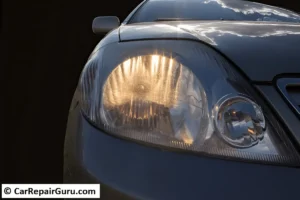
Causes of Flickering Headlights
Flickering or dim headlights are not just inconvenient—they may signal underlying electrical issues in your vehicle. Here are the common causes:
- Failing Alternator:
The alternator supplies power to your car’s electrical components and charges the battery. If it’s malfunctioning, the voltage output can become inconsistent, causing headlights to flicker. - Blown Fuses or Faulty Relays:
Fuses protect electrical circuits, while relays control the power flow. A blown fuse or a malfunctioning relay in the headlight circuit can disrupt the steady supply of electricity. - Loose or Corroded Connections:
Wiring and connectors that have loosened or corroded over time may impede the power flow, resulting in flickering lights. - Weak or Dying Battery:
If the battery struggles to hold a charge, it may not supply enough power for consistent headlight operation, especially at idle. - Faulty Light Bulbs or Assemblies:
Aging bulbs or damage to the headlight assembly can also cause dim or intermittent lighting.
Identifying the root cause is essential to resolving the problem effectively and ensuring safe nighttime driving.
Steps to Fix Headlight Issues
Fixing flickering or dim headlights involves a systematic approach to diagnose and address the issue. Follow these steps:
1. Check and Clean Connectors
- Inspect for Corrosion: Examine the connectors at the back of the headlights for signs of rust or dirt.
- Clean the Contacts: Use a wire brush or contact cleaner to remove corrosion and improve electrical conductivity.
- Ensure Tight Connections: Confirm that the connectors are securely attached to prevent interruptions in power flow.
2. Test the Headlight Voltage Output
- Use a Multimeter: Set the multimeter to DC voltage and test the power output at the headlight connector while the car is running.
- Compare Readings: A healthy system should show consistent voltage (usually around 12–14 volts). Fluctuations could indicate alternator or wiring problems.
3. Replace Faulty Components
- Change Blown Fuses: Check the vehicle’s fuse box for blown fuses and replace them with ones of the correct amperage rating.
- Inspect and Replace Bulbs: If the bulbs are old or damaged, replace them with high-quality, compatible ones.
4. Address Alternator and Battery Issues
- Check Alternator Output: If testing reveals inconsistent voltage, the alternator may need repair or replacement.
- Inspect the Battery: Ensure the battery is fully charged and capable of holding a charge. Replace it if necessary.
5. Professional Diagnostics for Complex Issues
- If wiring issues or other advanced electrical problems are suspected, seek professional assistance. They have specialized tools to diagnose and repair intricate circuits.
By addressing flickering or dim headlights promptly, you enhance visibility and safety while driving. Regular maintenance of your car’s electrical system can help avoid these issues altogether.
Wiring and Fuse Problems
Common Wiring Issues in Cars
Electrical wiring forms the backbone of your car’s electrical system, connecting components and delivering power where it’s needed. However, several common problems can arise:
- Frayed or Damaged Wires:
- Over time, wires may wear out due to vibration, friction, or heat.
- Exposure to rodents or mishandling during repairs can also cause physical damage to wiring.
- Damaged wires can lead to intermittent or complete power loss to connected components.
- Corroded or Loose Connectors:
- Moisture and dirt can cause corrosion at connection points, disrupting the flow of electricity.
- Loose connectors may result in inconsistent power delivery, causing flickering lights or malfunctioning accessories.
- Short Circuits:
- When two exposed wires touch, it creates a short circuit, which can blow fuses or even start a fire in severe cases.
- Improper Modifications or Repairs:
- Incorrectly installed aftermarket devices or poorly executed wiring repairs can create vulnerabilities, leading to electrical failures.
Proper inspection and maintenance of wiring can prevent these issues from escalating into costly repairs.
How to Replace Blown Fuses
Blown fuses are one of the most straightforward electrical issues to diagnose and fix. Fuses protect electrical circuits from damage by breaking the connection when current exceeds safe levels.
1. Locate the Fuse Box:
- Check your car’s owner’s manual for the location of the fuse box.
- Fuse boxes are commonly found under the dashboard, near the glove compartment, or in the engine bay.
2. Identify the Blown Fuse:
- Use the diagram inside the fuse box cover to locate the circuit experiencing issues (e.g., headlights or wipers).
- Look for a fuse with a broken metal strip or discoloration, which indicates it’s blown.
3. Replace the Fuse:
- Match the blown fuse with a replacement of the same amperage rating (printed on the fuse or in the manual).
- Insert the new fuse firmly into the slot.
4. Test the Circuit:
- Turn on the affected electrical component (e.g., lights or radio) to ensure the problem is resolved.
- If the fuse blows again immediately, it indicates an underlying problem, such as a short circuit or overloaded circuit.
5. Use Spare Fuses and Tools:
- Keep spare fuses of various amperages in your car for emergencies.
- A fuse puller or needle-nose pliers makes removing and inserting fuses easier.
Preventing Wiring and Fuse Problems
- Regularly inspect wiring for wear or damage, especially in areas exposed to heat or movement.
- Protect wires with heat-resistant sleeves and ensure proper routing to avoid friction or kinks.
- Avoid overloading circuits with high-powered aftermarket devices unless the system is upgraded accordingly.
By staying proactive, you can ensure a reliable electrical system and avoid unexpected breakdowns caused by wiring or fuse issues.
Professional Help for Complex Issues

When to Seek Professional Electrical Repair
While some car electrical issues are easy to diagnose and fix, others require advanced tools and expertise. Here are situations where seeking professional assistance is essential:
- Persistent or Recurring Problems:
- If your car’s electrical system continues to malfunction despite replacing fuses or repairing wiring, a deeper issue like a failing control module or grounded circuit may exist.
- Professional diagnostic tools like advanced multimeters, oscilloscopes, or OBD-II scanners are necessary to pinpoint such problems accurately.
- Malfunctioning Control Units or Sensors:
- Modern cars rely heavily on electronic control units (ECUs) to manage everything from the engine to climate control. A faulty ECU can cause widespread issues that are difficult to isolate without manufacturer-specific tools.
- Electrical Fires or Burning Smells:
- A burning odor or signs of melted insulation indicate a potential electrical short or overheating circuit, both of which pose a fire hazard. This requires immediate professional intervention.
- Battery or Alternator Issues Beyond Repair:
- Testing and replacing major components like the alternator or starter may involve dismantling parts of the engine. Professionals have the expertise and tools to perform these repairs safely and efficiently.
- Complex Wiring Repairs or Customizations:
- Rewiring sections of the car, repairing harnesses, or installing aftermarket electronics like advanced infotainment systems require precision and adherence to electrical standards.
Why Professional Help Matters
Professionals have access to manufacturer-specific repair manuals, specialized diagnostic tools, and training to tackle complex electrical systems in modern vehicles. Attempting to fix advanced issues without the right knowledge or tools could lead to further damage, higher repair costs, or safety risks.
For peace of mind and long-term reliability, it’s wise to leave complicated electrical problems to certified mechanics or electricians specializing in automotive systems.
Conclusion
Addressing common car electrical problems promptly is essential to maintaining your vehicle’s safety, reliability, and performance. Neglecting issues like a weak battery, faulty alternator, or damaged wiring can lead to more severe complications, including unexpected breakdowns, costly repairs, or even accidents due to malfunctioning lights or safety systems.
Regular maintenance, timely inspections, and understanding the signs of potential electrical problems allow you to catch issues early and avoid inconvenience. While many problems, such as replacing fuses or cleaning battery terminals, can be handled by car owners, seeking professional assistance for complex issues ensures accurate diagnosis and long-term solutions.
By prioritizing the upkeep of your vehicle’s electrical system, you not only enhance your driving experience but also ensure your safety and that of others on the road. Keep your car in optimal condition, and enjoy peace of mind during every journey.
FAQ:
Q1: What are the most common car electrical problems?
A1: Issues like dead batteries, alternator failures, blown fuses, faulty wiring, and starter motor problems are among the most common car electrical problems.
Q2: How can I tell if my alternator is failing?
A2: Signs of a failing alternator include dim or flickering headlights, unusual noises such as a whining or grinding sound, dashboard warning lights, and difficulty starting the car.
Q3: What tools do I need to troubleshoot car electrical problems?
A3: Essential tools for diagnosing car electrical issues include a multimeter to measure voltage and continuity, a test light for circuit checks, and basic hand tools like pliers and screwdrivers.
Q4: Why do my headlights flicker while driving?
A4: Flickering headlights may be caused by a failing alternator, loose or corroded connectors, damaged wiring, or a weak battery. Identifying the root cause promptly can prevent further issues.
Q5: How can I prevent electrical issues in my car?
A5: Regular maintenance, such as checking battery health, inspecting and cleaning connections, replacing old wiring, and promptly addressing minor problems, can help prevent larger electrical issues.
